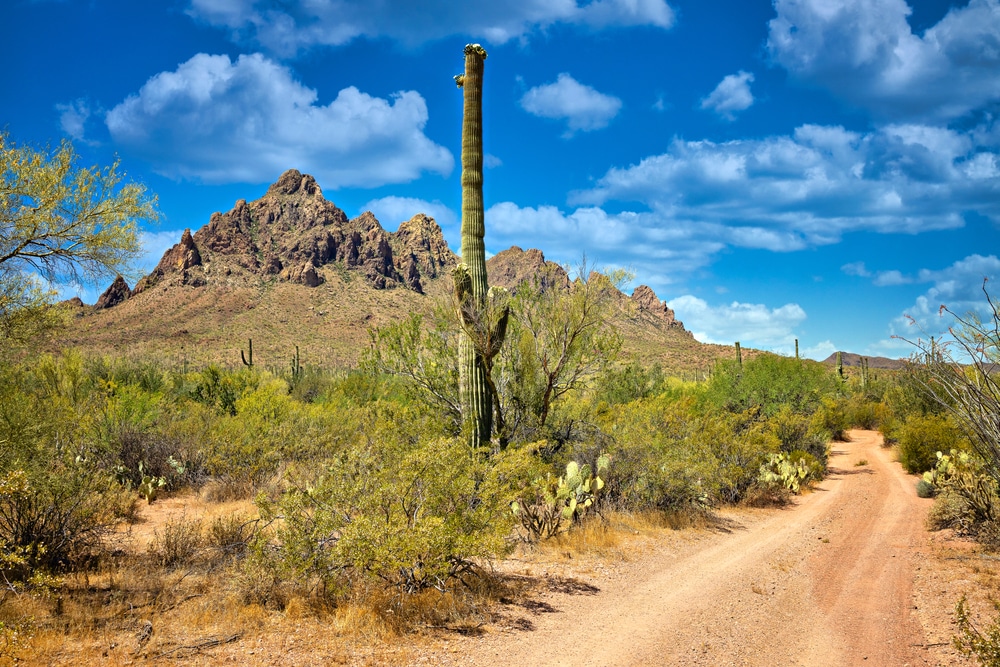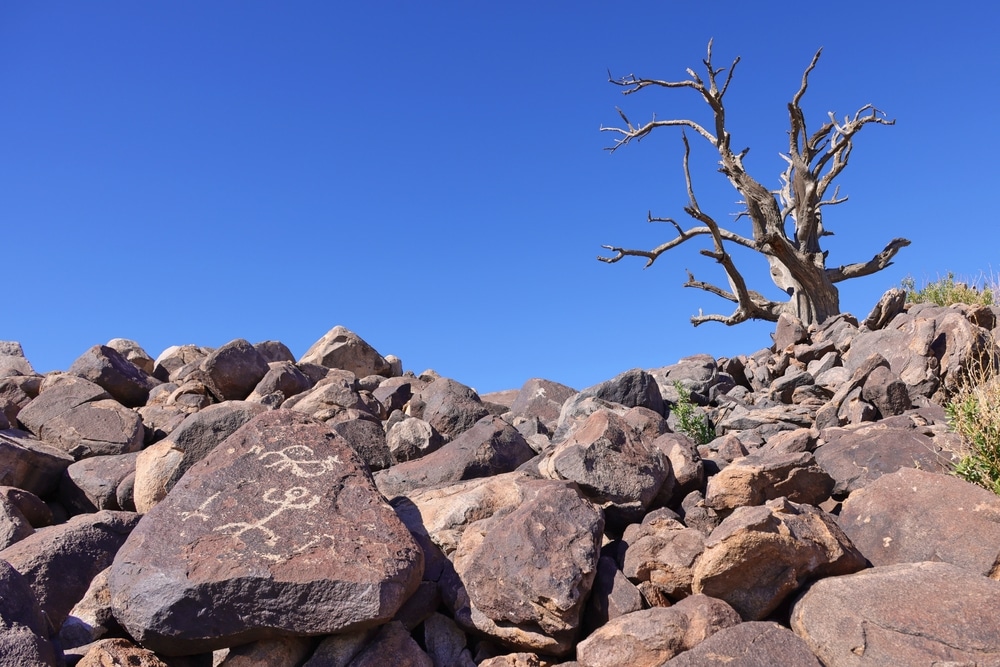Nestled in the Sonoran Desert northwest of Tucson, Ironwood Forest National Monument stands as a testament to Arizona’s remarkable biodiversity and cultural heritage. Established in June 2000 by Presidential Proclamation, this 129,000-acre expanse of federal land protects one of the richest stands of ironwood trees in the Sonoran Desert ecosystem. The monument takes its name from the desert ironwood tree (Olneya tesota), a remarkable species that can live for over 800 years and serves as both habitat and sustenance for numerous desert creatures.
The landscape of Ironwood Forest National Monument is characterized by rugged mountain ranges including the Silver Bell, Waterman, Sawtooth, and Roskruge Mountains, which rise dramatically from broad valleys studded with magnificent saguaro cacti, dense ironwood forests, and diverse plant communities. These varied terrains support an extraordinary array of flora and fauna, many of which are endemic to the Sonoran Desert region.

Ironwood Forest National Monument is home to a variety of desert wildlife. The monument’s ironwood trees and diverse habitats support species such as:
The best times for wildlife watching are early morning and late afternoon.
The monument’s unique ecosystem is home to many iconic Sonoran Desert plants. Key species include:
Spring (March–May) is the best time to visit for wildflowers, including bright orange globemallows and golden poppies, which bloom after winter rains.

Ironwood Forest National Monument offers unique hiking opportunities, with trails leading through desert washes, rocky canyons, and scenic mountain ranges. While there are no developed trails, visitors can explore the area on foot. Popular areas include:
Bring a map, GPS, and plenty of water, as trails are unmarked, and the terrain can be challenging.

The rugged mountains, towering saguaros, and unique desert light make Ironwood Forest National Monument a fantastic location for photography. Capture:
The monument’s remote location also makes it an excellent spot for night photography and capturing the stars.

Ironwood Forest National Monument contains significant cultural and historical sites, including petroglyphs and remnants of ancient Hohokam settlements. While exploring, you may find:
These sites are protected by federal law—take only pictures and leave artifacts undisturbed.

For those seeking solitude and an immersive desert experience, dispersed camping is allowed within the monument. There are no developed campgrounds, so visitors must bring all supplies and follow Leave No Trace principles. Camping tips:

The monument’s diverse habitats attract a variety of bird species, making it a great spot for birdwatching. Look for:
Bring binoculars and a bird guide to enhance your experience.
With minimal light pollution, Ironwood Forest National Monument is a great spot for stargazing. On clear nights, you can see:

The monument’s rugged mountains and desert plains feature fascinating geological formations. Key areas include:
The varied geology of the monument offers a glimpse into the region’s ancient past.

| Category | Details |
|---|---|
| Location | Southern Arizona, near Tucson and Marana |
| Established | June 9, 2000 |
| Managed By | U.S. Bureau of Land Management (BLM) |
| Size | Approximately 129,000 acres (52,225 hectares) |
| Main Attractions | Rugged desert landscapes, Ironwood trees, Ragged Top Mountain, and archaeological sites |
| Ecosystem | Sonoran Desert ecosystem with saguaro cacti, palo verde trees, and ancient ironwood trees |
| Wildlife | Includes desert bighorn sheep, mule deer, Gila monsters, desert tortoises, and over 200 bird species |
| Cultural Significance | Contains over 200 archaeological sites, including remnants of ancient Hohokam and Tohono O’odham cultures |
| Recreation Activities | Hiking, wildlife viewing, photography, and exploring desert landscapes |
| Popular Areas | Ragged Top Mountain (a popular hiking and wildlife viewing area), Silverbell Mountains |
| Nearby Landmarks | Saguaro National Park, Organ Pipe Cactus National Monument, Tucson |
| Climate | Hot summers and mild winters with occasional rainfall during the monsoon season |
| Camping | Dispersed camping is allowed in designated areas; no developed campgrounds |
| Accessibility | Rugged terrain; roads and trails are mostly unpaved, requiring high-clearance or 4WD vehicles |
| Entrance Fee | No entrance fee |
| Fun Fact | The Ironwood tree, one of the oldest and hardest desert trees, can live for over 1,500 years, providing critical habitat and food for desert wildlife. |
Beyond its ecological significance, the monument holds deep cultural value, with evidence of human presence dating back more than 5,000 years. From ancient Hohokam settlements to historic mining operations, the lands within Ironwood Forest tell the story of human interaction with this challenging yet bountiful desert environment.
As part of Arizona’s extensive network of public lands, Ironwood Forest National Monument provides valuable opportunities for recreation, education, and scientific research while preserving critical habitat and watershed functions. Managed by the Bureau of Land Management (BLM), the monument represents an important piece of America’s conservation legacy in the Southwest and a vital resource for understanding and appreciating the unique character of the Sonoran Desert ecosystem.
Ironwood Forest National Monument is located in Pima and Pinal Counties, approximately 25 miles northwest of Tucson, Arizona. The monument is accessible primarily via several unpaved roads that branch off from major highways:
From Tucson: Take Interstate 10 west to the Avra Valley Road exit, then head west and follow signs to the monument.
From Phoenix: Travel south on Interstate 10 toward Tucson, taking the Marana exit and following Silverbell Road southwest.
It’s important to note that access to the monument requires travel on dirt and gravel roads that may be rough and occasionally impassable after heavy rains. High-clearance vehicles are recommended for exploring the interior of the monument, particularly in the more remote sections. Four-wheel drive is advisable during monsoon season (July through September) when flash flooding can alter road conditions rapidly.
Unlike many national parks and monuments, Ironwood Forest has no entrance stations, visitor centers, or developed facilities within its boundaries. The nearest visitor information is available at the BLM Tucson Field Office, where visitors can obtain maps and current information about conditions.
The defining feature of Ironwood Forest National Monument is undoubtedly its exceptional stands of desert ironwood trees. These ancient sentinels, with their silver-gray foliage and purple blooms, create habitat “nurseries” that support over 674 plant and animal species. The ironwood tree is considered a keystone species in the Sonoran Desert ecosystem, as it provides shade, moisture retention, and nutritional support for countless desert organisms.
The monument’s diverse landscapes include:
The Waterman, Silver Bell, Sawtooth, and Roskruge Mountains provide dramatic elevation changes from approximately 1,800 to 4,261 feet at the summit of Ragged Top Mountain, the most iconic peak in the monument. These mountains are composed of ancient volcanic and sedimentary rocks that reveal hundreds of millions of years of geological history.
Between the mountain ranges lie expansive bajadas (alluvial fans) and plains that support classic Sonoran Desert vegetation communities dominated by saguaro cacti, palo verde trees, creosote bush, ocotillo, and cholla.
Although the monument contains no perennial streams, it includes numerous washes and arroyos that flow briefly during rainstorms. These xeroriparian corridors support denser and more diverse vegetation than surrounding uplands, creating critical wildlife habitat.
The monument’s biodiversity is remarkable even by Sonoran Desert standards, including:
Ragged Top Mountain, with its distinctive silhouette, hosts an exceptionally diverse plant community that includes species rarely found elsewhere in the region, making it an area of special scientific interest within the monument.
Despite its proximity to Tucson, Ironwood Forest National Monument offers a remarkable wilderness experience with fewer crowds than many of Arizona’s more developed public lands. The monument provides numerous recreational opportunities for those seeking to immerse themselves in the Sonoran Desert environment:
While the monument lacks developed trail systems with signage and facilities, it offers numerous opportunities for cross-country hiking and exploration. Popular hiking destinations include:
Ragged Top Mountain: The most challenging and rewarding hike in the monument, this steep scramble to the summit of Ragged Top requires good physical condition and some route-finding skills, but rewards hikers with panoramic views of the surrounding desert. The hike is approximately 3 miles round-trip with 1,500 feet of elevation gain.
Waterman Mountains: Offering more moderate terrain than Ragged Top, these mountains provide excellent opportunities for day hiking with spectacular views and opportunities to observe desert wildlife.
Desert Washes: The sandy beds of ephemeral streams create natural pathways through the monument that are often easier to navigate than the rocky uplands and provide opportunities to observe dense desert vegetation and wildlife.
Hikers should be aware that no developed water sources exist within the monument, and shade is limited. All hiking excursions should be planned with ample water supplies (at least one gallon per person per day) and awareness of desert safety practices.
The diverse habitats of Ironwood Forest National Monument support an abundance of wildlife, making the area excellent for wildlife observation and photography. Notable opportunities include:
Birdwatching: With over 200 bird species recorded, including Gambel’s quail, cactus wrens, gila woodpeckers, and various raptors, the monument offers excellent birdwatching, particularly in the early morning hours.
Desert Bighorn Sheep: The Waterman Mountains support a small population of these magnificent mammals, which can occasionally be spotted on rocky slopes, particularly near water sources after rainfall.
Reptile Observation: The monument is home to numerous reptile species, including the Gila monster, desert tortoise, and several rattlesnake species, which can be safely observed with proper caution during warmer months.
The best wildlife viewing opportunities typically occur during the cooler seasons (October through April) and around dawn or dusk when desert animals are most active.
Ironwood Forest National Monument permits dispersed camping throughout most of its acreage, providing excellent opportunities for overnight desert experiences:
Dispersed Camping: Visitors may camp anywhere within the monument that is at least 0.25 miles from water sources and away from archaeological sites. No developed campgrounds, water, or toilet facilities exist within the monument.
Stargazing: Due to its distance from major urban light sources, the monument offers exceptional dark sky viewing. The minimal development and high desert air clarity create ideal conditions for astronomical observation, particularly during the new moon phase.
Campers should practice Leave No Trace principles, pack out all waste, and be aware of fire restrictions, which are frequently in place due to the sensitive desert ecosystem and wildfire risk.
The monument’s network of primitive roads provides opportunities for exploring by high-clearance vehicles and OHVs:
Designated Routes: OHV use is permitted only on designated routes, which are marked on BLM maps available at the Tucson Field Office or online. Cross-country travel is strictly prohibited to protect sensitive desert soils and vegetation.
Scenic Drives: Several rough but passable dirt roads create loop opportunities through different sections of the monument, allowing visitors to experience diverse landscapes without extensive hiking.
Popular routes include the Silverbell Road, which traverses the eastern portion of the monument, and various spur roads that penetrate deeper into the protected area.
The lands within Ironwood Forest National Monument have witnessed human activity for thousands of years, creating a rich cultural landscape that complements its natural values:
The monument contains significant archaeological sites that document ancient human habitation:
Hohokam Culture: Evidence of the Hohokam people, who inhabited the region from approximately 300 BCE to 1450 CE, can be found throughout the monument. Rock art (petroglyphs), pottery shards, and remnants of agricultural features provide insights into their adaptation to desert life.
Trincheras Sites: The monument contains several examples of “trincheras” – terraced hillside sites constructed by prehistoric peoples for purposes that likely included agriculture, defense, and ceremonial activities.
These archaeological resources are protected by federal law, and visitors should observe them respectfully without disturbing artifacts or structures.
The Silver Bell Mountains within the monument contain evidence of historic mining activity that shaped regional development:
Silver Bell Mining District: Active from the late 19th century through much of the 20th century, this district produced significant amounts of copper, as well as smaller quantities of silver, gold, and other minerals.
Historic Structures: Remnants of mining operations, including adits (horizontal passages), tailings piles, and occasional structural ruins, can be observed in certain areas, offering glimpses into Arizona’s mining heritage.
While much of the monument’s mining history occurred prior to current environmental regulations, these sites now provide opportunities to understand both technological innovation and the environmental challenges associated with resource extraction in arid lands.
The monument holds ongoing cultural significance for indigenous peoples of the region:
Tohono O’odham Nation: The lands within the monument are part of the traditional territory of the Tohono O’odham people, who continue to maintain cultural connections to the landscape.
Traditional Uses: The desert ironwood tree and numerous other plants found within the monument have been used traditionally by indigenous peoples for food, medicine, tools, and ceremonial purposes for countless generations.
Visitors should respect the cultural heritage of the area and understand that some locations may hold special significance for Native American communities.
The experience of visiting Ironwood Forest National Monument varies dramatically with the seasons, and timing can greatly enhance visitor enjoyment:
Winter (December-February): Perhaps the most comfortable season for extended exploration, with daytime temperatures typically ranging from 60-75°F (15-24°C) and cool nights. Winter occasionally brings light rainfall that can trigger early blooming of certain desert plants.
Spring (March-May): The prime season for wildflower observation, particularly after winters with adequate rainfall. The desert ironwood trees typically bloom in late April to early May, creating a purple haze across the landscape. Daytime temperatures gradually increase from pleasant to very warm during this period.
Summer (June-September): Extreme heat dominates summer days, with temperatures regularly exceeding 100°F (38°C) and occasionally reaching 110°F (43°C) or higher. Outdoor activities should be limited to early morning hours. The monsoon season (typically July-September) brings dramatic thunderstorms, potential flash flooding, and a brief but intense period of desert renewal.
Fall (October-November): A second prime visitation period as temperatures moderate following summer extremes. Fall lacks the wildflower displays of spring but offers stable weather conditions ideal for hiking and camping.
Wildflower Blooms: Following wet winters, spring wildflower displays can be spectacular, typically peaking in March and early April. Species include Mexican gold poppies, lupines, owl clover, and numerous cactus blossoms.
Monsoon Storms: The summer monsoon season provides opportunities to witness impressive thunderstorms and the dramatic transformation of dry washes into temporary streams. This period also triggers summer blooming of certain plants and increased activity among some wildlife species.
Migratory Birds: Spring and fall bring migratory bird species passing through the monument, temporarily increasing avian diversity beyond the year-round resident species.
Visitors planning extended activities should check weather forecasts carefully and always prepare for the extreme conditions possible in desert environments, particularly the need for adequate water, sun protection, and awareness of flash flood potential.
Ironwood Forest National Monument faces several conservation challenges that reflect broader issues affecting public lands throughout the Southwest:
Urban Encroachment: The monument’s proximity to the growing Tucson metropolitan area creates increasing pressure from development along its boundaries, potentially affecting wildlife corridors and viewsheds.
Invasive Species: Non-native plants such as buffelgrass present serious threats to the native ecosystem by altering fire regimes and outcompeting native vegetation.
Illegal Activities: Despite protection status, the monument occasionally experiences problems with illegal dumping, unauthorized off-road vehicle use, and vandalism to natural and cultural resources.
Climate Change: Rising temperatures and changing precipitation patterns threaten to alter the delicate ecological balance of the Sonoran Desert ecosystem, potentially affecting the regeneration of ironwood trees and other key species.
Several organizations work in partnership with the BLM to address these challenges:
Friends of Ironwood Forest: This non-profit organization conducts regular volunteer events for invasive species removal, trash cleanup, and monitoring of sensitive resources.
Scientific Research: Ongoing studies by university researchers and agency scientists help document the monument’s biodiversity and inform management decisions.
Educational Outreach: Programs targeting local communities and visitors aim to build understanding of the monument’s ecological and cultural significance.
Interagency Cooperation: Collaboration between the BLM, Arizona Game and Fish Department, U.S. Fish and Wildlife Service, and other agencies helps coordinate conservation efforts across jurisdictional boundaries.
Visitors can contribute to conservation efforts by following Leave No Trace principles, staying on designated routes, reporting violations to BLM rangers, and potentially participating in volunteer opportunities through partner organizations.
Best Entry Points: While numerous dirt roads provide access to different portions of the monument, the most reliable access routes are from Avra Valley Road and Silverbell Road on the eastern side.
Maps and Navigation: Detailed maps are essential, as cellular service is limited or non-existent in much of the monument. The BLM Tucson Field Office provides maps, or they can be downloaded from the BLM website prior to visits.
Permits: No specific permits are required for general visitation or dispersed camping. However, commercial activities, organized group events, and scientific research may require special permits from the BLM.
Water: No reliable water sources exist within the monument. Visitors should carry at least one gallon of water per person per day, and more during hot weather.
Communication: Cell phone coverage is spotty or non-existent throughout much of the monument. Consider carrying satellite communication devices for emergencies when venturing into remote areas.
Desert Hazards: Visitors should be aware of potential encounters with venomous reptiles, thorny plants, and extreme temperature variations between day and night. Appropriate footwear, long pants, and first aid supplies are recommended.
Flash Floods: During monsoon season, be extremely cautious around washes and low-lying areas, which can transform from dry channels to dangerous torrents within minutes.
Visitors are encouraged to follow Leave No Trace principles:
While the monument itself lacks services, several nearby communities provide amenities:
Marana: Located approximately 10 miles east of the monument’s eastern boundary, this growing community offers fuel, groceries, restaurants, and limited lodging options.
Tucson: About 25 miles southeast of the monument, Tucson provides comprehensive services including hospitals, outdoor recreation retailers, extensive accommodation options, and the BLM Tucson Field Office where visitors can obtain detailed information.
Ironwood Forest National Monument represents an accessible yet authentic opportunity to experience the biological richness and cultural depth of the Sonoran Desert ecosystem. While lacking the developed facilities and name recognition of Arizona’s national parks, the monument offers something increasingly precious: the chance to connect with desert landscapes in their natural state, with minimal crowds and infrastructure.
The ancient ironwood trees that give the monument its name stand as living witnesses to centuries of natural and human history in this harsh yet bountiful environment. Their persistence in the face of challenging conditions reflects the broader resilience of the Sonoran Desert ecosystem – a quality that becomes increasingly valuable as climate change and development pressures intensify throughout the Southwest.
For visitors seeking to understand Arizona’s public lands beyond the famous destinations, Ironwood Forest provides a perfect introduction to the BLM’s conservation mission and the critical role these less-heralded protected areas play in preserving biodiversity, watershed function, and cultural heritage.
Whether you come to hike the challenging slopes of Ragged Top, photograph the spring wildflower displays, camp under pristine dark skies, or simply drive the monument’s remote roads, Ironwood Forest offers an experience of Arizona’s desert landscapes that combines accessibility with authenticity – a combination increasingly rare in our most famous public lands.
By visiting with respect, preparation, and awareness, you become part of the ongoing story of this remarkable landscape – a story that spans thousands of years of human interaction with one of North America’s most distinctive desert ecosystems.
We use cookies to improve your experience on our site. By using our site, you consent to cookies.
Manage your cookie preferences below:
Essential cookies enable basic functions and are necessary for the proper function of the website.
Statistics cookies collect information anonymously. This information helps us understand how visitors use our website.
Marketing cookies are used to follow visitors to websites. The intention is to show ads that are relevant and engaging to the individual user.